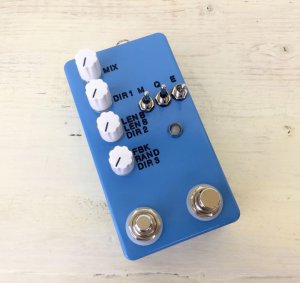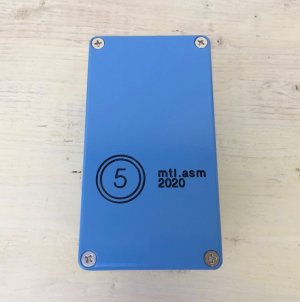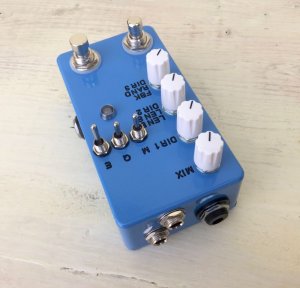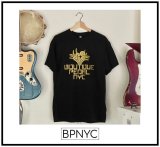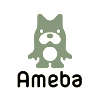The Montreal Assembly Count to 5(Five) 2020
Connectivity:
Facing the pedal with the text the right way up, the input jack is the one slightly more too the right, output slightly more to the left on the top side of the unit. The expression pedal input is the jack on the right side of the unit.
Power requirements are 9VDC negative tip for all versions. Version h, i and j require around 100mA, while k and l require 150mA.
How to use:
The pedal has three main modes. On rev h/i theses are selected with the "MODE" switch. On rev j/k the same switch is simply labelled "M". In all modes the "MIX" knob functions the same, and simply blends the wet and dry signal of the effect. On rev h/i fully ccw is fully wet. On rev j/k this has been changed to fully cw being fully wet.
Mode 1 (mode toggle up):
In this mode a buffer of fixed length is constantly written to at a fixed speed/ It is simultaneously read back at a variable speed with possibility of feedback to the write head.
The DIR 1 knob controls the direction and speed of the read head.
The LEN B knob selects the length of the buffer.
The FBK knob controls the amount of feedback from the read head to the write head.
Also note the LEN B knob has discrete settings. The buffer length will jump as you move the knob between about 10 lengths. Each length is half/double the next/previous setting. You will see the LED change color when you change the length.
The "EXP" switch on rev h/i and "E" switch on rev j have identical functionality. In fact, E is just shorthand for EXP which stands for Expression pedal selection switch. If you have an expression pedal plugged in you can assign it to either the DIR 1, LEN B or FBK function using the 3 way switch.
Currently Rev k only:
Because mode 1 can really pump out some high pitches it may be desirable for some to have a low pass filter on the effected signal. You can do this in mode 1 by holding down the soft foot swtich and turning the DIR 1 knob. When you hold down the footswitch the LED will go green. While the footswitch is down, turning the DIR 1 knob ccw will lower the cutoff frequency of the low pass filter. Max cw is no filter applied/ very high cut off frequency. When you find the cut off you like simply release the soft footswitch and go back to using mode 1 as normal. The filter is only applied in mode 1, it is not global. The filter setting will however stay in effect if you leave Mode 1 and return. The setting will be lost if the device is powered down.
The filter feature will be added into the next firmware release for all older board revisions. I expect to release this at the end of February/Beginning of March 2016, currently this feature only appears in the rev k firmware.
Rev h/i only:
Accessing/altering the global quantization setting can be done in Mode 1 on rev h/i units as of firm ware 0.93. The purpose of this is to To set the quantization mode hold down the soft foot switch and move DIR 1. There are 6 modes and they are spaced evenly throughout the travel of the DIR 1 pot.
Mode 2 (mode toggle middle):
In this mode up to four seconds of sound can be recorded, and then played back in shorter segments randomly.
The DIR 1 knob controls the direction and speed of the read head.
The LEN S knob controls the length of the resampled slices.
The RAND knob effects how randomly the slices are selected. Ccw sets it to no randomness at all, the sample is always played from the beginning. Cw allows the start of the slices to be chosen from anywhere in the original recording.
The soft switch is used to record a sample. Hold it down to record. If you record for more than 4 seconds it will simply wrap around and layer on top of the first four seconds. Once you release the soft switch the sample begins playing according to the setting of the knobs.
While the sample is playing you can record a new sample while the old one is still playing. Simply hold down the soft switch again and when you release the new sample will play.
To stop and cancel the sample, tap the soft switch quickly.
Initially the LED will be flashing blue in this mode, before recording anything. While recording it will be red, and while playing back it will be blue. After a tap to cancel it will also be flashing blue.
The E/EXP switch functions as in Mode 1, but instead assigns to DIR 1, LEN S and RAND.
Mode 3 (mode toggle down):
In this mode up to 8 seconds can be recorded and played back by up to three read heads simultaneously.
The DIR 1 knob controls the direction and speed of the first read head.
The DIR 2 knob controls the direction and speed of the second read head.
The DIR 3 knob controls the direction and speed of the third read head.
The soft switch is used to record a sample. Hold it down to record. If you record for more than 8 seconds it will simply wrap around and layer on top of the first 8 seconds. Once you release the soft switch the sample begins playing according to the setting of the knobs.
While the sample is playing you can layer on top of the original recording by holding down the soft switch again.
To stop and cancel the sample, tap the soft switch quickly.
Initially the LED will be flashing blue in this mode, before recording anything. While recording it will be red, and while playing back it will be blue. After a tap to cancel it will also be flashing blue.
In mode 3, the E/EXP switch controls how many read heads are active. When E is up only DIR 1 will have an effect since only 1 read head is playing. E in the middle enables 2 read heads, controlled by DIR 1 and DIR 2 knobs. E down enables all three read heads and DIR 1,2,3 will all have an effect. If you plug in an expression pedal in mode 3, it will always control DIR 1.
Rev j/k 'Q' switch:
On the rev j and k models the quantization can be set in any mode at any time. Simply push the toggle up or down to cycle through the 6 possible quantizations. The possible modes are:
No quantization.
Chromatic quantization.
Whole tone scale quantization.
Diminished triad quantization.
Augmented triad quantization.
Perfect fifths and octaves quantization.
With the most current firmware (0.931) for rev h/i boards all six modes are available by holding the soft switch in mode 1, and moving the DIR1 knob. The original firmware for these boards only included 3 quantization modes (1, 2 and 6 in the above list).
Transcendence mode:
Under normal operating conditions the sample buffer is cleared when either LEN B in mode 1 is adjusted or the mode switch position is changed. Essentially all modes start with an empty buffer. Based on user feedback some people would prefer this did not happen, so the shipping firmware for rev k has a new mode which I have called transcendence, since the data in the buffer "transcends" mode switches.
At the moment this mode is only implemented on the latest rev k firmware. However similar to the filter feature, it will be added to all older models in the next major firmware release.
Activating transcendence:
To enable transcendence simply bypass the pedal and then hold down the soft footswitch. You will see that the LED alternates blue/green/blue/green about every .5 seconds. If you release the footswitch while the LED is green you will enable transcendence. If you release when the LED is blue you will disable transcendence.
When the pedal is re engaged all blue led indicators will change to green, and all green to blue if transcendence is active. SO for example in mode 1 where normally the LED alternated blue or red depending on th LEN B setting, it will alternate green or red. And when you hold down the soft switch to adjust the filter it will turn blue instead of green etc. Similar logic applies to the LED in mods 2 and 3.
Consequences of transcendence:
When flipping between modes the audio buffer will no longer wipe clean, instead it will keep what was written in the previous mode(s). An example would be that you could record a loop in Mode 3, then flip to mode 2 and have that exact loop played randomly, or flip again up to mode 1 and get the echoes added etc. There are a few caveats and subtleties to this though which are outlined in the rest of this section.
In Mode 1, while transcendence is active the buffer is not wiped when LEN B is changed.
In mode 2 there are no longer 2 swapping 4 second buffers. There is only one 8 second buffer. If you record a sample and release the soft footswitch it will start to play back, similarly to how mode 2 would work without transcendence. However, when you record again it will write over the current playback buffer, instead of a second unheard one. So an interesting effect of this is that you can hold down the soft switch while recording and have the audio be randomized more in "real time" instead of having to record a loop, then release the footswitch to start playing that loop.
If you record a loop from stop (ie you tapped he soft switch and had a blinking green led) in either mode 2 or 3, the length of that loop will transcend when changing modes as the loop length and will not be changed until you stop playback again in either mode 2 or 3. For example, you freshly record a loop in mode 2 that is 3 seconds long. When you move to mode 3 it will play this loop right away and any layers added will loop around this 3 second base. But then if you tap the soft switch to stop playback and record a new loop of 4 seconds, when you flip to mode 2 now it will randomize over a 4 second sample etc.
Mode 1 follows this theme somewhat, but is a bit more complicated depending on what is happening before entering mode 1. If a loop has been recorded in mode 2 or 3 and you flip to mode 1 the maximum LEN B setting will correspond to the length of the loop, not 8 seconds. However if no loop was recorded or transcendence was enabled while in Mode 1, the max length achieved by LEN B is 8 seconds as usual.
When you leave mode 1 in transcendence, mode 2 or 3 will automatically start playing. The length of the original recorded sample is maintained if your journey was something like: record in mode2/3 flip to mode 1, flip back to mode 2/3. However if no loop was recorded when entering mode 1, or transcendence was enabled in mode 1, then the length of the sample played in mode 2/3 is determined by the setting of LEN B at the time of exiting Mode 1.
Facing the pedal with the text the right way up, the input jack is the one slightly more too the right, output slightly more to the left on the top side of the unit. The expression pedal input is the jack on the right side of the unit.
Power requirements are 9VDC negative tip for all versions. Version h, i and j require around 100mA, while k and l require 150mA.
How to use:
The pedal has three main modes. On rev h/i theses are selected with the "MODE" switch. On rev j/k the same switch is simply labelled "M". In all modes the "MIX" knob functions the same, and simply blends the wet and dry signal of the effect. On rev h/i fully ccw is fully wet. On rev j/k this has been changed to fully cw being fully wet.
Mode 1 (mode toggle up):
In this mode a buffer of fixed length is constantly written to at a fixed speed/ It is simultaneously read back at a variable speed with possibility of feedback to the write head.
The DIR 1 knob controls the direction and speed of the read head.
The LEN B knob selects the length of the buffer.
The FBK knob controls the amount of feedback from the read head to the write head.
Also note the LEN B knob has discrete settings. The buffer length will jump as you move the knob between about 10 lengths. Each length is half/double the next/previous setting. You will see the LED change color when you change the length.
The "EXP" switch on rev h/i and "E" switch on rev j have identical functionality. In fact, E is just shorthand for EXP which stands for Expression pedal selection switch. If you have an expression pedal plugged in you can assign it to either the DIR 1, LEN B or FBK function using the 3 way switch.
Currently Rev k only:
Because mode 1 can really pump out some high pitches it may be desirable for some to have a low pass filter on the effected signal. You can do this in mode 1 by holding down the soft foot swtich and turning the DIR 1 knob. When you hold down the footswitch the LED will go green. While the footswitch is down, turning the DIR 1 knob ccw will lower the cutoff frequency of the low pass filter. Max cw is no filter applied/ very high cut off frequency. When you find the cut off you like simply release the soft footswitch and go back to using mode 1 as normal. The filter is only applied in mode 1, it is not global. The filter setting will however stay in effect if you leave Mode 1 and return. The setting will be lost if the device is powered down.
The filter feature will be added into the next firmware release for all older board revisions. I expect to release this at the end of February/Beginning of March 2016, currently this feature only appears in the rev k firmware.
Rev h/i only:
Accessing/altering the global quantization setting can be done in Mode 1 on rev h/i units as of firm ware 0.93. The purpose of this is to To set the quantization mode hold down the soft foot switch and move DIR 1. There are 6 modes and they are spaced evenly throughout the travel of the DIR 1 pot.
Mode 2 (mode toggle middle):
In this mode up to four seconds of sound can be recorded, and then played back in shorter segments randomly.
The DIR 1 knob controls the direction and speed of the read head.
The LEN S knob controls the length of the resampled slices.
The RAND knob effects how randomly the slices are selected. Ccw sets it to no randomness at all, the sample is always played from the beginning. Cw allows the start of the slices to be chosen from anywhere in the original recording.
The soft switch is used to record a sample. Hold it down to record. If you record for more than 4 seconds it will simply wrap around and layer on top of the first four seconds. Once you release the soft switch the sample begins playing according to the setting of the knobs.
While the sample is playing you can record a new sample while the old one is still playing. Simply hold down the soft switch again and when you release the new sample will play.
To stop and cancel the sample, tap the soft switch quickly.
Initially the LED will be flashing blue in this mode, before recording anything. While recording it will be red, and while playing back it will be blue. After a tap to cancel it will also be flashing blue.
The E/EXP switch functions as in Mode 1, but instead assigns to DIR 1, LEN S and RAND.
Mode 3 (mode toggle down):
In this mode up to 8 seconds can be recorded and played back by up to three read heads simultaneously.
The DIR 1 knob controls the direction and speed of the first read head.
The DIR 2 knob controls the direction and speed of the second read head.
The DIR 3 knob controls the direction and speed of the third read head.
The soft switch is used to record a sample. Hold it down to record. If you record for more than 8 seconds it will simply wrap around and layer on top of the first 8 seconds. Once you release the soft switch the sample begins playing according to the setting of the knobs.
While the sample is playing you can layer on top of the original recording by holding down the soft switch again.
To stop and cancel the sample, tap the soft switch quickly.
Initially the LED will be flashing blue in this mode, before recording anything. While recording it will be red, and while playing back it will be blue. After a tap to cancel it will also be flashing blue.
In mode 3, the E/EXP switch controls how many read heads are active. When E is up only DIR 1 will have an effect since only 1 read head is playing. E in the middle enables 2 read heads, controlled by DIR 1 and DIR 2 knobs. E down enables all three read heads and DIR 1,2,3 will all have an effect. If you plug in an expression pedal in mode 3, it will always control DIR 1.
Rev j/k 'Q' switch:
On the rev j and k models the quantization can be set in any mode at any time. Simply push the toggle up or down to cycle through the 6 possible quantizations. The possible modes are:
No quantization.
Chromatic quantization.
Whole tone scale quantization.
Diminished triad quantization.
Augmented triad quantization.
Perfect fifths and octaves quantization.
With the most current firmware (0.931) for rev h/i boards all six modes are available by holding the soft switch in mode 1, and moving the DIR1 knob. The original firmware for these boards only included 3 quantization modes (1, 2 and 6 in the above list).
Transcendence mode:
Under normal operating conditions the sample buffer is cleared when either LEN B in mode 1 is adjusted or the mode switch position is changed. Essentially all modes start with an empty buffer. Based on user feedback some people would prefer this did not happen, so the shipping firmware for rev k has a new mode which I have called transcendence, since the data in the buffer "transcends" mode switches.
At the moment this mode is only implemented on the latest rev k firmware. However similar to the filter feature, it will be added to all older models in the next major firmware release.
Activating transcendence:
To enable transcendence simply bypass the pedal and then hold down the soft footswitch. You will see that the LED alternates blue/green/blue/green about every .5 seconds. If you release the footswitch while the LED is green you will enable transcendence. If you release when the LED is blue you will disable transcendence.
When the pedal is re engaged all blue led indicators will change to green, and all green to blue if transcendence is active. SO for example in mode 1 where normally the LED alternated blue or red depending on th LEN B setting, it will alternate green or red. And when you hold down the soft switch to adjust the filter it will turn blue instead of green etc. Similar logic applies to the LED in mods 2 and 3.
Consequences of transcendence:
When flipping between modes the audio buffer will no longer wipe clean, instead it will keep what was written in the previous mode(s). An example would be that you could record a loop in Mode 3, then flip to mode 2 and have that exact loop played randomly, or flip again up to mode 1 and get the echoes added etc. There are a few caveats and subtleties to this though which are outlined in the rest of this section.
In Mode 1, while transcendence is active the buffer is not wiped when LEN B is changed.
In mode 2 there are no longer 2 swapping 4 second buffers. There is only one 8 second buffer. If you record a sample and release the soft footswitch it will start to play back, similarly to how mode 2 would work without transcendence. However, when you record again it will write over the current playback buffer, instead of a second unheard one. So an interesting effect of this is that you can hold down the soft switch while recording and have the audio be randomized more in "real time" instead of having to record a loop, then release the footswitch to start playing that loop.
If you record a loop from stop (ie you tapped he soft switch and had a blinking green led) in either mode 2 or 3, the length of that loop will transcend when changing modes as the loop length and will not be changed until you stop playback again in either mode 2 or 3. For example, you freshly record a loop in mode 2 that is 3 seconds long. When you move to mode 3 it will play this loop right away and any layers added will loop around this 3 second base. But then if you tap the soft switch to stop playback and record a new loop of 4 seconds, when you flip to mode 2 now it will randomize over a 4 second sample etc.
Mode 1 follows this theme somewhat, but is a bit more complicated depending on what is happening before entering mode 1. If a loop has been recorded in mode 2 or 3 and you flip to mode 1 the maximum LEN B setting will correspond to the length of the loop, not 8 seconds. However if no loop was recorded or transcendence was enabled while in Mode 1, the max length achieved by LEN B is 8 seconds as usual.
When you leave mode 1 in transcendence, mode 2 or 3 will automatically start playing. The length of the original recorded sample is maintained if your journey was something like: record in mode2/3 flip to mode 1, flip back to mode 2/3. However if no loop was recorded when entering mode 1, or transcendence was enabled in mode 1, then the length of the sample played in mode 2/3 is determined by the setting of LEN B at the time of exiting Mode 1.
